
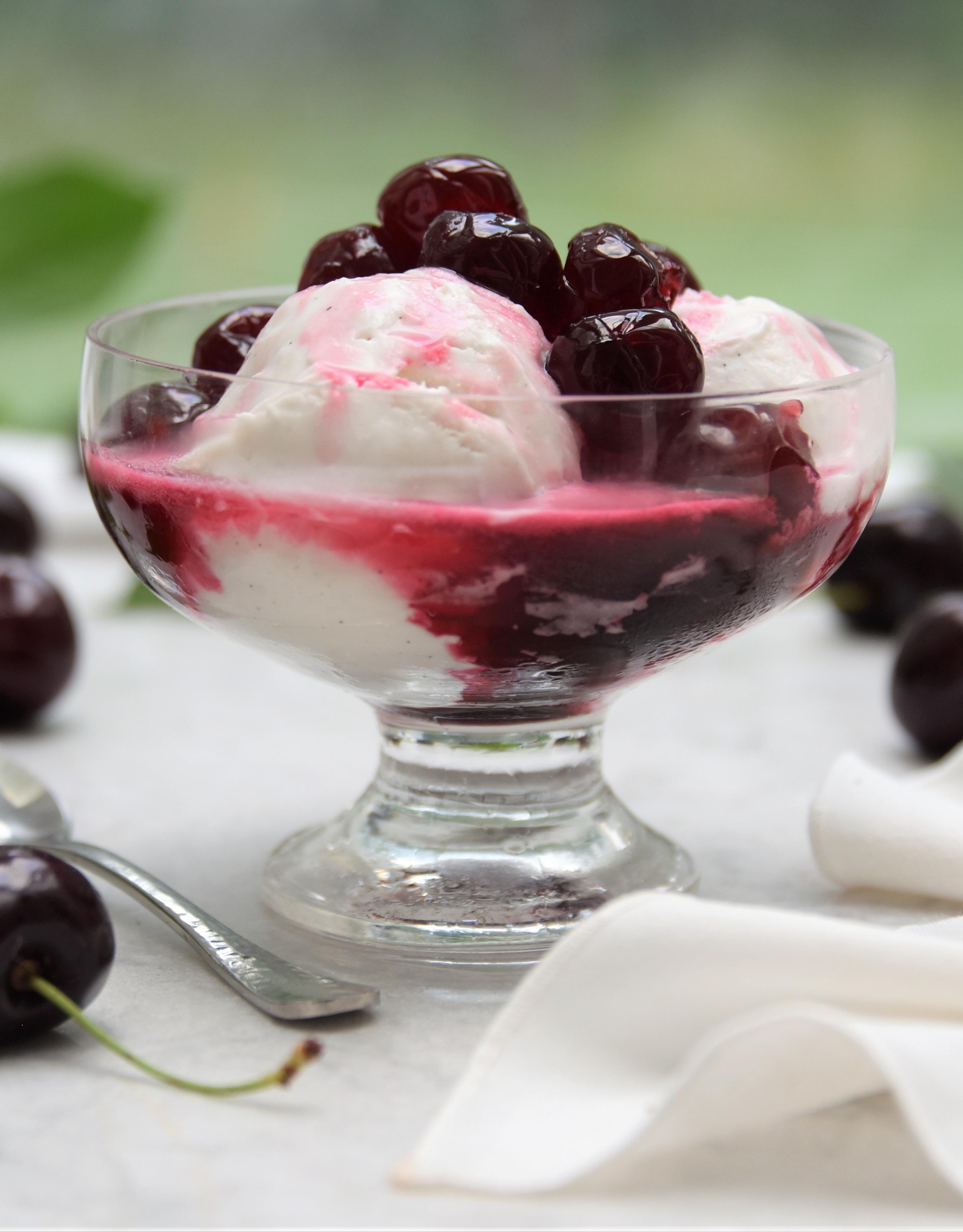






Ethol Hotelling opened the Ethol Hotelling Millinery Shop in downtown Kalamazoo in 1929. She went into business at a time where most women didn’t, and made quite a success of it.
Ethol opened during a time when women wore hats during the daytime. Her hats were one-of-a-kind, beautifully made and considered expensive – women wore her hats with great pride and her shop was the top hat store in Kalamazoo.
When the bee-hive hairstyle came into fashion, Ethol transitioned the shop into a ready-to- wear dress shop and then branched out into other clothing and accessories.
Ethol was a woman before her time, traveling by train to Chicago and New York on regular buying trips. She enjoyed travel, and visited California and Hawaii. Her customers came from as far away as California and New York. Ethol served as a personal buyer for the Kalamazoo elite and wrote a book, “Hats ‘n Chats,” about her personal and business memoirs. The book was available at the Otsego Library for years, but is no longer in circulation. The family has access to the book she authored.
Born and raised in Otsego, she grew up in an entrepreneurial family. Her parents, Frederick and Dorothea “Dora” Hotelling, ran the local theater showing silent films, and spent their summers on Pine Lake. When



Ethol was in middle school, the family moved to Kalamazoo, where she stayed the rest of her life.
Many have shared their fond memories of Ethol and her store on the Vanished Kalamazoo Facebook page, including: “I saw one of her hats at the Van Buren Historical Museum in Hartford last weekend.”
“I remember her when she used to come into Roger’s Hair-a-Scope to get her hair done by Roger Snow. I was a stylist there ‘92-’94.” “I loved Ethol.” “She was a true gem!” “My mother and grandmother shopped there often. I finally convinced Mom to buy me a dress there, too! That had to be in the 60’s.” “Mom was friends with Ethol. She was a nice lady. We visited her in her house which was fascinating.” “I always saw her at the Beacon Club when I worked there. She was very cool.” “My wife picked

up a “Chapeaux” hat by Ethol at an Estate Sale.” “All the rage, back in the day.”
The store was located at 415 W. Lovell Street, across from the KIA for many years. Ethol resided in her shop for some time during the depression, to keep the store afloat.
The home, one of Kalamazoo’s most impressive Queen Anne’s, is known as The Henry Gilbert House, because it was the second home of the Kalamazoo Gazette founder. Gilbert later owned a furniture manufacturing business and became the wealthiest man in Kalamazoo.
The home was built in 1888, around the time that Gilbert retired from active community and business life. Gilbert and his second wife, Myra resided in the home for a decade before they both passed away on the same day February 7, 1898.
It was later owned by William Shakespeare Jr., a local civic and business leader, who founded the Shakespeare Company that manufactured fishing equipment. The home was listed on the National Register of Historic Places in 1983. Today, Scott Tribby sells and repairs musical instruments from the home.
The home that she lived in was located in the Westnedge Hill area. The Sears Modern Home, was purchased through the Sears, Roebuck and Co., mail order catalog. She resided in the home until she was 100 years old. Family members now own the home.
Ethol Hotelling, an entrepreneur before her time, was in business for 28 years, until 1976. Sadly, she passed away on June 7, 2005, at the age of 101. She is buried in the same city in which she was born, at the Mountain Home Cemetery in Otsego.
One of Ethol’s cardboard hatboxes is on display at the KVCC Museum, in the Colorful Collection Exhibit, in the green color display case, which will be on display until August 31st.
Jackie Merriam
Credits: Vanished Kalamazoo Facebook Page, KG 6/9/2005, Wikipedia.com, KPL Local History Room.


Is there anything more relaxing than sitting in the garden, listening to the tweets and songs of birds as they flit and flirt throughout your plants? If you’re a serious birder looking to add more species to your life list, you’ll want to attract a wide variety of feathered friends to your backyard. And while it’s fun to fill feeders and watch birds swoop in for a snack, there’s an easier way to entice these cuties to enjoy your entire yard: add plants that produce food birds love.
For hummingbirds, you’ll want a wide variety of nectar-producing flowers.
Many birds are also attracted to insects found on plants in your garden, so forgo the pesticides and allow the birds to snack on pesky pests. But adding seed-producing plants to your garden beds, borders, or containers is one of the easiest ways to feed your favorite birds–especially those too shy to visit feeders.
Remember to leave a treasure trove of food, nesting materials, and shelter for birds in your garden in the fall.
To attract all types of birds, include a water feature in your garden. A mister, bird bath, fountain, or even a small dish of water lets them enjoy a drink, bathe, and cool off during hot days.
While many plants produce seeds that birds enjoy, you’ll find new cultivars bred for better disease resistance, smaller spaces, or bigger blooms that not only produce savory seeds for birds—but also look lovely in your garden.
We’ve highlighted five plants birds love for their seeds while also looking great all season long, too.

I love to grab lunch at the People’s Food Co-op in downtown Kalamazoo. Although they have a wonderful hot bar full of many delicious foods, I typically choose the breakfast bur-

When you think of seed sources for birds, a bright, giant sunflower may be the first plant that pops in your mind. After all, if you regularly fill your feeders, sunflower seeds dominate many commercial bird food mixes. (Have you ever watched finicky birds sort through seed mixes, tossing less desirable seeds to the ground in search of tasty sunflowers?) Growing annual sunflowers announces to the birds that you’re a gardener with good taste.
Newer compact cultivars offer small-space gardeners a chance to enjoy growing sunflowers, both for their cheerful, charming flowers as well as the seed. Whether you’re looking for massive flowerheads on tall stalks, multi-branched varieties with a long bloom period, or an array
rito when I’m in a rush and need to eat on the road without making a mess. At checkout, they always ask if I would like to round up to the nearest dollar and I always say, “yes!”
Last week when I was at the checkout, I asked how the round-up money is used. The cashier shared a few details and drew my attention to a huge chalkboard on the wall, which is the scorecard for their “Change for Change” program.
I was shocked to learn that $18,178 was raised by rounding up last year, which helped 12 different local charities. So far this year (Jan.Apr., 2025), $5,788 has been raised, and donated to these worthy causes: the Institute of Public Schools, Lat-
of colors, you’ll find hundreds of sunflower options.
If you love watching pollinators enjoy your garden, plant coneflowers—and then leave the seed heads for the birds to enjoy once the blooms fade. You’re sure to spot goldfinches, bluejays, and cardinals snacking on coneflower seeds. Ten species of echinacea are endemic to North America, with colors that include purple, lavender, and yellow. However, newer hybrids offer a rainbow of colors—red, orange, pink, green, and even multi-colored blooms. Plus, many cultivars offer stronger stems, better disease resistance, compact habits, and masses of blooms throughout the season.
If you love a burst of late-season color, along with seedheads that lend winter interest, Black-Eyed Susan (Rudbeckia) makes a terrific addition to your garden’s bird food smorgasbord. With pretty yellow petals contrasting with the dark “eye” of the center cone that produces tasty seeds for the birds, Black-Eyed Susan is a classic plant in many gardens.
New cultivars bring benefits like compact forms, interesting colors, and better disease resistance to the mix. Whichever plant you choose, American goldfinches, nuthatches, chickadees, and towhees will appreciate the seeds.
The workhorse of the garden, marigolds provide pretty pops of color among veggies, help attract pollinators while also repelling pests, and look lovely planted in borders along paths or filling containers. But did you know that birds love the seeds, too? Who knew that the humble, annual marigold provides so many benefits in the garden?
5. Zinnia
Who doesn’t love zinnias? Sprinkle some of these annual seeds in the garden, and you’ll enjoy a brilliant burst of low-maintenance color in the heat of summer.
With fresh varieties of tried-andtrue classic flowers, you’ll love the colorful, unique, interesting additions to your garden—and then enjoy watching the birds feast on the seeds. Article courtesy of the National Garden Bureau
Wedel’s Nursery, Florist & Garden Center
ter Rain Outreach, Bread and Roses Childcare and the Kalamazoo Earth Day Committee. Upcoming donations will go to the Edison Neighborhood Association in May, the Kalamazoo Refugee Resource Collaboration in June and the Refugee Friends Free Store in July.
I tip my hat off to the People’s Food Co-op for initiating this effective program. The simple gesture of rounding up and donating spare change is helping to provide funds to groups that are making an impact in our community.
Jackie Merriam

Graphic Designer: Lauren Ellis Editor and Publisher: Jackie Merriam (269) 217-0977 - goodnews.jackie@gmail.com
This publication does not specifically endorse advertisers or their products or services. No part of this publication may be reprinted or otherwise reproduced without the written permission from the publisher.

Do we keep ourselves busy so that we don’t have time to reflect on what’s right and what’s wrong in our lives? We don’t sit with ourselves and question the value we put on our wants and what we need, which in turn creates the demand for our work and our time. At some point, there was a shift in my life that came without me being fully aware. The hustle, always a hustle, but more hustle than I think I was used to. I recently heard it be said that we work to provide for the life we want, but there isn’t enough time to experience the life we want because we are always working to provide for it. What I need and want is more time. More time with my kids, more conversations with my aging parents, more hikes with my husband. This is not something that I can buy. Experiences I can buy, yes, but the actual slowdown and sitdown time cannot be bought.
Summer is here, and is already very busy. But I’m making choices to prioritize time. I went backpacking and hiking with my husband and friends at Turkey Run State Park. A


not-so-secret, special state park. Who knew that Indiana had terrain that would excite this Michigirl? Ravines, crevasses, rock formations, and ladders to climb. It was wonderful and

slightly challenging. I highly recommend it, with encouragement to wear the right type of shoes and anticipate getting muddy and wet. Another not-so-secret special place that I don’t need to travel much distance to is my kitchen table. Grilled hot dogs,
burgers, watermelon, and corn on the cob bring my family together to sit with each other and connect, even if just for a little bit. The other day, my dad stopped by and we just sat and chatted at the kitchen table. All this takes is time. And there’s never enough of it. Especially if I choose to hustle over making the time.
It’s been over one year since my husband and I did a puzzle. Puzzles take two things: time and a table, our kitchen table. It takes a few more things, but I imagine you get what I’m saying. A simple act of placing a puzzle box on the kitchen table chooses time over work over hustle. I’m slowly putting together the pieces of the life I want and need, and it takes time. Time I’m thankful to have, but time I need to choose. Here’s hoping for more kitchen table time and trail time for myself and you all as well.
20 free original art prints are randomly included in this month’s issue of the Good News Paper.
Peace, Love, and Art. -Amy Instagram: @amylgieschen

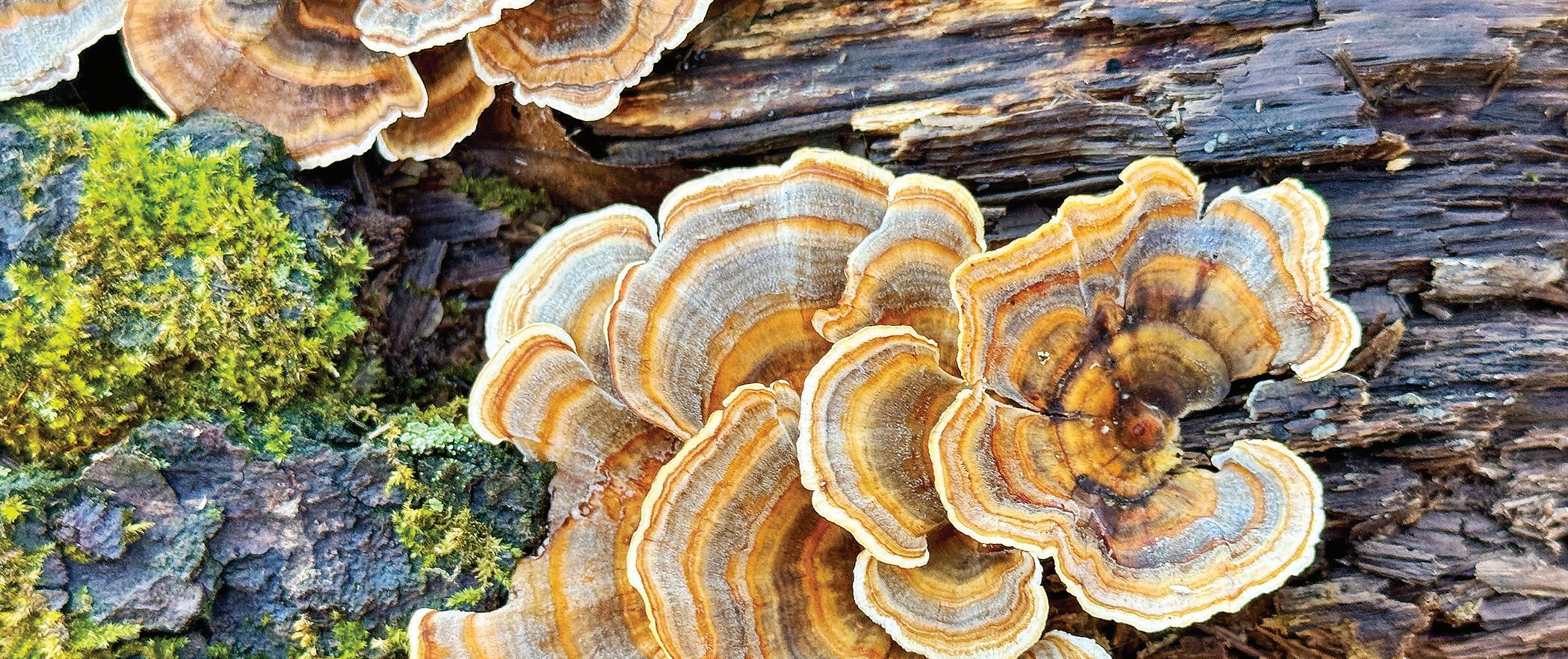
Have you ever stopped to wonder what’s happening beneath your feet when you step over a mushroom? That little cap is just the tip of a vast underground network busy shaping life as we know it.
Most of us walk past mushrooms without a second thought—the assorted “toadstools” pushing up through damp soil, clusters of shelf fungi clinging to tree trunks, or strange jelly-like growths on branches. But fungi are more than odd-looking embellishments. They are nature’s recyclers, quiet engineers of the ecosystem, and life-sustaining allies to trees and plants.
The forest floor thrives on decay. When a tree falls, fungi break down wood fibers, release nutrients, and clear space for new life. Without fungi, imagine a world where nothing rotted—just mountains of fallen trees and dead plants piling up endlessly. Sounds pretty bleak, right? Some fungi, like Turkey Tail (Trametes versicolor), decompose dead wood, while others, such as molds and slime molds, feast on decaying leaves.
Fungal decomposition plays a crucial role in breaking down wood. The three main types of rot—brown, white, and soft—each affect wood differently. Brown rot, or “dry rot,” mainly affects softwoods, breaking down cellulose and leaving a crumbly, reddish-brown structure that fractures into cube-like chunks. White rot targets both cellulose and lignin, leaving wood soft, spongy, and often lighter in color. Turkey

Tail is a common white rot fungus. Soft rot thrives in persistently wet environments, forming small cavities in wood, creating a honeycombed or cube-like appearance.
But fungi do more than decompose. Many form underground networks called “mycorrhizae,” partnering with tree and plant roots in a remarkable exchange—fungi help trees absorb water and minerals, and in return, trees share sugars made through photosynthesis. This isn’t just a loose association; fungi physically connect with roots, either wrapping around them (ectomycorrhizal fungi) or penetrating root cells (endomycorrhizal fungi). These networks extend beyond a tree’s own roots, linking multiple plants in what some call the “Wood Wide Web.” Through this system, trees can send distress signals about pests or drought, prompting their neighbors to boost defenses. Older “mother trees” even share nutrients with younger saplings, helping them survive.
A terrific book that explores this is “Finding the Mother Tree” by Suzanne Simard, a forest ecologist who uncovered the secrets of fungal networks.
Beyond forests, fungi appear in fields, backyards, and even sidewalks. Some, like Chicken of the Woods, are edible and prized by foragers. Others, like Amanita species, are dangerously toxic. The Destroying Angel (Amanita bisporigera), one of the deadliest mushrooms, is found in our area and contains amatoxins that cause fatal
organ failure if ingested.
Slime molds, often mistaken for fungi, can suddenly appear as strange, pulsating blobs on logs or mulch, moving—ever so slowly—in search of food.
Some fungi, like the Jack-OLantern and Honey Mushroom, glow in the dark through bioluminescence. On a campout I led for a summer camp, the young campers were amazed to see glowing sticks throughout the woods once it got dark, amazed by their eerie green light. I remember these excited campers scouring surrounding woods collecting glowing twigs. They then placed them as small “nightlight” piles next to their sleeping bags. By morning, the glow had vanished— just ordinary sticks again, thanks to “foxfire,” a bioluminescent fungus found in rotting wood.
Then there are fungi like Ophiocordyceps, which hijack insect bodies, forcing them into bizarre behaviors.
An ant, driven by forces beyond its control, climbs to a high leaf, clamps down with its mandibles, and waits it fate as a fungal stalk erupts from its dead body to spread spores for the next generation.
Despite their importance, fungi remain among the least studied organisms. New species are still being discovered, and researchers are exploring ways fungi might help humans—whether in medicine, environmental cleanup, or even replacing plastics with biodegradable fungal materials.
For example, “mycoremediation” refers to fungi breaking down pollutants. Oyster mushrooms (Pleurotus ostreatus) can decompose petroleumbased contaminants. In a study led by mycologist Paul Stamets, oyster mushrooms detoxified diesel-contaminated soil, turning toxic sludge into fertile ground within weeks. The fungi metabolized hydrocarbons, reducing pollution and attracting insects and plants, jumpstarting ecosystem recovery.
“Mycelium-based packaging” is another promising alternative to plastic. Companies are growing mycelium— the root-like structure of fungi—into moldable materials used for packaging, furniture, and insulation. Unlike plastic, mycelium decomposes naturally within weeks, making it an eco-friendly replacement for Styrofoam.
So, the next time you see a mushroom on a damp log or tiny caps popping up in your yard after rain, take a closer look. They’re part of an ancient, unseen network—one that keeps life moving forward in ways we are only beginning to understand.
Fungi have been around for over a billion years, shaping ecosystems long before humans arrived. Now, as we search for sustainable solutions to modern problems, perhaps the answer has been right under our feet all along.
James D. Coppinger






For book recommendations from your Kalamazoo Public Library Staff go to www.kpl.gov/blog/
BattlBattle of the Bookstor e of Bookstoreses Ali Brady (Berkley)
When their boss decides to merge their beloved bookstores, romance-reader Ryan and literary "Ice Queen" Josie vie for the title of bookstore manager. Readers will enjoy the witty banter, loveable cast of characters, spicy scenes, literary references, and the representation of the romance genre and romance bookstores as inclusive stories and places for anyone and everyone to find themselves.
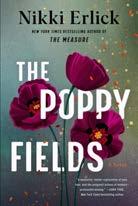
TThePhePoppoppyFieyFielldsds Nikki Erlick (William Morrow)
What if you could sleep your way through grief, but there was a chance you'd forget about the love you shared with a loved one?Four strangers make a trip to a remote sleep lab, each with a different reason for their journey.This touching novel is a tribute to the resilience of the human heart and the journeys we all must go through to heal.
NJ


King of Ashes
S.A. Cosby (Flatiron Books: Pine & Cedar)
The Carruthers are a family living with multiple secrets and the trauma of losing their mother while the siblings were still young. When Roman, the oldest brother, returns home after their father is in a terrible accident, he gets drawn into gang warfare trying to protect his family. This page-turner is full of secrets.

Meet Me at the Cr Me the Crossrossroadsoads
Megan
Seven mysterious doors suddenly appear in different places across the globe, and when they open, they appear to lead to new dimensions in the universe. Two Black twin sisters get caught in the mystery as one sees paradise while the other sees peril. A spellbinding story about the choices that can both bring us together and tear us apart.
TTheLheListeners:
MaggieStiefvater (Viking)

Joan is the manager of a resort hotel in West Virginia. Life is good until the U.S. is pulled into WWII and the hotel's only guests are detained Axis diplomats. While Joan is very good at keeping secrets, this adds strain on the staff. Readers who adored Stiefvater's YA books will welcome this historical fiction that reads like a classic spy thriller.
—Kimberly
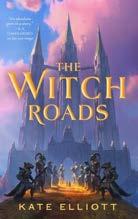
TThe Witch Roads he Kate
(Tor Books)
TX
Audrey
This compelling romance alternates between two timelines, propelling the story along and driving readers to find out how Grant and Tess go from teenagers in love to gubernatorial candidates with opposing political views who haven't seen each other for 25 years. Secrets and complicated family dynamics make this a page-turning summer read.
JulJulieTieTudor Is Not a Ps udor Is Not a Psyychopathchopath Jennifer Holdich (Sourcebooks Landmark)
TThe Phoenix P he Phoenix Pencil Company encil Company Allison King (William Morrow)
Monica is determined to reunite her beloved Grandmother Yun with her long-lost cousin after learning about her family's talent for imbuing ordinary pencils with extraordinary magic, capable of bringing memories to life. The way the author weaves together multiple generations and their intertwined stories creates a compelling saga spanning time and cultures.

Deputy courier Elen's journey across the Tranquil Empire in service to a haughty and haunted prince is a tale thick with political intrigue, family secrets, class hierarchy, dangerous escapes, and a deeply strange and touching friendship. Elliott captures the spirit of epic fantasy with a moving story, compelling characters, and a world full of ancient magic begging to be explored.
TTheStoheStollenLenLififeofeof CoColletteMaretteMarceauceau
Kristin Harmel (Gallery Books)
This dual-timeline WWII saga tells the story of a feisty young Parisian woman learning the family legacy of jewel thievery, taking from the undeserving wealthy to help those in need. Harmel brilliantly creates absorbing characters, harrowing scenes, and, ultimately, goodness in a tale full of twists, moral dilemmas, and the enduring power of forgiveness.
SoFSoFarGonearGone Jess Walter (Harper)
A zany thriller about a former journalist whose two grandchildren suddenly arrive at his door after their mother goes missing. He must then contend with the religious militia his son-inlaw is involved in while tracking down his daughter. A heartfelt story about feeling lost and burnt out—and finding a way forward and re-connecting.
TTheRivheRiver's Daughter: er's Daughter: AMemoirAMemoir Bridget Crocker (Spiegel & Grau)

Be sure to check out our social media for the
Pick annotations!
Feeling tipsy? There is a reason for it. We have passed the tipping point on climate change. While some summers may be an exception, climate scientists predict a 98% chance that the next five years will surpass recorded history for high temperatures.
Ironically, the use of air conditioners contributes to climate change. Air conditioners contribute approximately 3% of greenhouse gas emissions. When temperatures soar, however, keeping cool can become a life saver, not just keeping us more comfortable, but in some cases even preventing heat stroke.
To help reduce our use of air conditioners, there are several changes we can make to our homes to maintain the cool and lower the thermostat.
When you find that it is time to replace the roof on your home, choose lighter color shingles. Dark absorbs heat, but light can help reflect it. Roofs called “cool roofs” can reduce peak cooling demand as much as 27%.
Plant shade trees and foliage around your home to provide cover from the sun.
Insulation prevents excessive heat in summer while maintaining heat in winter.
Install windows with an R-rating of 5 for energy efficiency. Reflective (anti-UV) window films applied over glass can be effective, especially when

combined with thicker thermal curtains or cellular blinds. Automated blinds can be programmed to open during shady times of day but close during full sun.
Add awnings above most exposed windows to keep out the sun. Retractable awnings can be rolled back when desired. Awnings can also add shade to a patio.
Invest in a dehumidifier. Higher humidity levels can make the temperature feel much more unpleasant. The ideal level of humidity is be-









tween 40% to 50%.
Ceiling fans help to circulate air in the room, adding a cooling effect. Blades should turn counterclockwise to push air down.
If you have an air conditioner, don’t forget annual maintenance. Window units should have their filters cleaned monthly. Check air filters, fan belts, and blowers in your unit. A dusty AC unit has to work harder, driving up your bill. A well-maintained unit should last 10 to 15 years.
Use a portable AC unit that you
can move from room to room, wherever you need it the most. Multi-split units installed on walls near the ceiling, popular in Europe, can also be an efficient way to cool.
Fire up the grill and keep the kitchen cool on the hottest days. If outdoor cooking isn’t your thing, prepare meals that don’t require cooking or use appliances such as slow cookers or air fryers that don’t add heat to the room.
Install an attic ventilator or attic fan to move heat from your attic out of the home. Attics can heat up to 150 degrees Fahrenheit, pushing heat into the home.
Experts vary on recommended settings on your thermostat, so your location and your comfort may have to be your guide. General recommendations usually range around 75 to 78 degrees during the daytime if you are home. Set the temperature 7 to 10 degrees higher during daytime hours when you are away. Each degree above 72 can save approximately 3% on your electric bill. For best sleep, lower the thermostat to 72 degrees or turn it off completely if the outdoor temperature drops and open the windows instead.
And then there’s ice cream. Always a good choice, whatever the season.
Zinta Aistars




Until I researched the origin of sparklers, I didn’t realize they aren’t just a Fourth of July tradition. Weddings. New Year’s Eve. Birthdays. Many celebrations utilize the combustible sticks that can be twirled around in darkness as sparks of light cascade in multiple directions.
I can’t remember the first time I twirled sparklers for the Fourth of July. When the tradition took hold for me is less important than the fact that for five decades and counting, the joy of spending time waving sparklers around the yard with my mom still occurs.
There is one particular memory I have when I was fourteen. Each time I find myself reflecting on the photograph my mind framed for life, I think of a professor who taught us

to “go back and mine the sculpture.” He was referring to a specific small group activity we did during class in which he indicated we would go back and extract meaning from the experience for years to come.
The memory is of my paternal grandfather running through the yard at my grandparent’s getaway lake home. He was three years shy of his sixtieth birthday, and it was the first time he had experienced the fun of sparklers.
It would also be his last, for Grandpa passed away nearly four months later from lung cancer.
I’ve pulled my mind’s photo from my heart’s treasure chest many times, “mining” the meaning that I’m meant to extract each time I view it. Gratitude for this shared time with

Grandpa the last months of his life. Awe of the miracle that he was able to quickly move across the yard given that he only had one of his two lungs. Sadness that it was his first and only time enjoying that kind of child innocent glee. Reverence for the gift I was being taught about full presence in the now, leaning fully into the moment at hand with happiness, thankfulness, and freedom from worry even though suffering and the certainty time would soon bring goodbye were also in his footsteps across the yard that night.
I read a quote one time by a person whose name I can no longer recall. “Don’t sweat the small stuff; it’s all small stuff.” I “mine” the image of my grandpa with sparklers, gleaning determination to maximize each day to
the best of my ability with peacefulness, playfulness, joyfulness, appreciation, simplicity, and love. I should add humbleness and gentleness, for these were also the things Grandpa exhibited as the sparks lit up the dark sky. I look at the image, not seeing concern if a sparkler didn’t light or if mosquitoes were trying to leave their mark. Nor do I see a mask trying to hide sorrow at what would inevitably come. The only thing I see is Grandpa’s eyes twinkling, not from the sparkler reflection but from his own child-like joy and the big smile on his face as he ran.
Wishing you a blessed Fourth of July.
Christine Hassing https://christinehassing.com



The Atomic Age began 80 years ago this July, and once Pandora’s Box was opened, nothing could close it. The first events of the age transpired with remarkable swiftness, largely because during World War II, the scientific quest to explore the building blocks of the universe became a military, industrial, and scientific race to end history’s greatest conflict.
The first self-sustained nuclear reaction, led by Rome-born Enrico Fermi, took place in December 1942 in a secret reactor under the bleachers at the University of Chicago’s football stadium. Just 32 months later, in early August 1945, most of humanity became aware of the power of the atom after the only two atomic weapons ever used against people were dropped on the Japanese cities of Hiroshima and Nagasaki. Hostilities ended six days later, and the war formally ended with Japan’s surrender aboard the U.S.S. Missouri in Tokyo Bay on September 2, 1945.
But the Atomic Age really began 21 days before the bomb was
dropped on Hiroshima. On July 16, 1945, a single test in the unpopulated desert near Alamogordo, New Mexico confirmed that a small amount of radioactive material such as uranium or plutonium contained enough energy to destroy many square miles, along with its residents. At 8:15 a.m. on that day, the first nuclear explosion took place at the Trinity Test Site. The test, conducted by the U.S. Army and led by Dr. Robert Oppenheimer and his team of scientists, confirmed that an atomic explosion could be performed and controlled— and that it would not ignite and consume the entire atmosphere of the planet, as some had feared.
Right from the beginning, humanity found an optimism with nuclear power, hoping that it could power our cities, vehicles, ships, and even aircraft and spaceships. But that optimism was constantly tempered with well-founded concerns about the loss of life, either by accident or intentionally.
Two physicists who assembled




“The Gadget”—the codename for the Trinity test bomb—died in nuclear accidents soon after the test. In late August 1945, Harry Daghlian was fatally irradiated when he grabbed a tungsten carbide brick that had dropped onto a 13.7-pound plutonium bomb core. Nine months later, Louis Slotin met a similar fate when a protective beryllium shield dropped during an experiment with the same plutonium core, which came to be known as the “Demon Core.” Importantly, both incidents resulted in an instantaneous eerie blue light and produced a critical mass of material—a sufficient amount to start a reaction and subsequent massive accident with substantial loss of life, such as those in Chernobyl, Ukraine in 1986, and Fukushima, Japan in 2011.
Since the Trinity test in 1945, there have been more than 2,120 nuclear tests underground, in the air, or underwater. There have been at least 32 accidents involving nuclear weapons, including bombers, ballistic missiles,


and submarines. Six nuclear weapons were lost and never recovered.
One of the victims of the Hiroshima bomb was a 21-year-old prisoner of war from Kalamazoo. Staff Sgt. Julius Molnar, a B-24 Liberator tail gunner, was one of 12 Americans killed by the blast. Molnar had been captured near Hiroshima six days earlier, on July 28, 1945, after his bomber was shot down. He was imprisoned at Chugoku Military Police Headquarters in Hiroshima, less than one-quarter mile from Ground Zero. He was one of the 150,000 people killed by the first atomic weapon used in warfare.
Tony Ettwein HistoryZoo1837@gmail.com
A. In the 1950s, atomic bomb tests were a tourist attraction in Las Vegas
B. SSgt Julius Molnar of Kalamazoo was one of 12 American prisoners of war killed by the Hiroshima bomb

Navigating Milestones: A Love Letter to Parents in Every Season
Whether your child is graduating from preschool, fifth grade, middle school, high school, or college, these milestones carry a swirl of emotions—joy, pride, nostalgia, and sometimes even a little heartache. Each stage invites us to pause, reflect, and feel deeply, not just about our children’s growth, but our own evolution as parents.
For the preschool parent, it’s almost surreal—your tiny explorer with wide, trusting eyes is stepping into a brand-new world. Their backpack might be bigger than they are, but so is their excitement. This moment is tender and powerful. You may find yourself tearing up at the thought of how quickly this day arrived, holding tight to the wonder and sweetness of these early years.
By fifth-grade graduation, things start to shift. Suddenly, your voice doesn’t carry quite the same weight, and peers become more influential. Your child is beginning the exhilarating (and occasionally exasperating) journey of self-discovery. It’s a time when eye rolls may replace hugs, but underneath it all, they’re still listening. Stay steady. Keep modeling

kindness, boundaries, and respect— even when it feels like they aren’t noticing. They are.
Then comes middle school gradua-



tion, and with it, the realization that your once little one is becoming more independent. They may challenge your rules or question your wisdom. This is completely normal. Don’t take it personally. Developmentally, they’re wired to test and stretch as they form their own sense of self. Stay the course with love and firm boundaries. You’re not just parenting a child—you’re guiding a young adult in the making. Create space for conversation. Family meetings can be a great way to invite their voice while reinforcing respect and unity.
High school graduation often hits the heart hardest. The years that once crawled now seem to sprint. You may find yourself revisiting old photos, remembering the sleepovers, soccer games, or late-night talks. A quiet house can be a jolt. You might question if you did enough. These reflections are natural. Whether you’re navigating this shift with a partner or on your own, allow yourself space to
grieve, to celebrate, and to rediscover who you are outside of parenting. This isn’t an ending—it’s a transformation.
And then… college graduation. Your child stands at the edge of adulthood, perhaps starting a job, moving to a new city, or even starting a family of their own. You might be surprised to find them seeking your advice again—this time with greater respect. They see you now through the lens of experience, not just authority. And you see them—not as the child they were, but as the person they’ve become. Pride and awe live side by side here.
Throughout all of these transitions, one truth remains: parenting is a lifelong relationship, not a role with an expiration date. Yes, the nature of your connection will change, but the roots of love, guidance, and presence hold strong.
You have raised a whole human being. And in doing so, you’ve grown too.
It’s okay to miss the chaos. To long for sticky fingers, loud living rooms, and late-night homework crises. But don’t forget to also embrace the quiet. Use this space to explore your own dreams, reconnect with yourself, and invest in the parts of your life that may have taken a backseat. You’re not done—you’re just entering a new chapter.
Most of all, remember this: your child may not remember whether the dishes were done or the laundry folded, but they will remember how you made them feel. They will carry your love—your presence, your laughter, your unwavering support—with them always.
So celebrate the milestones. Cry the tears. Laugh at the memories. Let go of perfection. And above all, keep showing up with love.
Because that’s what stays. That’s what shapes them. And that’s what they’ll remember.
Dr. Julie Sorenson, DMFT, MA, LPC



Inside the quiet, unassuming walls of a therapy office lies something powerful:
A sacred space.
A healing sanctuary.
A place where hearts can whisper the truths they’ve carried in silence.
These are the walls where people dare to bring their hardest stories — trauma, grief, anxiety, depression, shame, regret — and lay them bare, often for the very first time. Within these four walls (or through the glow of a virtual screen), healing begins.
Here, in this protected space, clients untangle their nightmares, peel back the layers of old wounds, and discover tools to gently dismantle the heavy armor they’ve built around themselves. Therapy becomes a space of both bravery and grace, where people make the bold choice to face fears, revisit painful memories, and rebuild battered relationships.
Healing isn’t a clean or linear journey — it’s messy, courageous, and
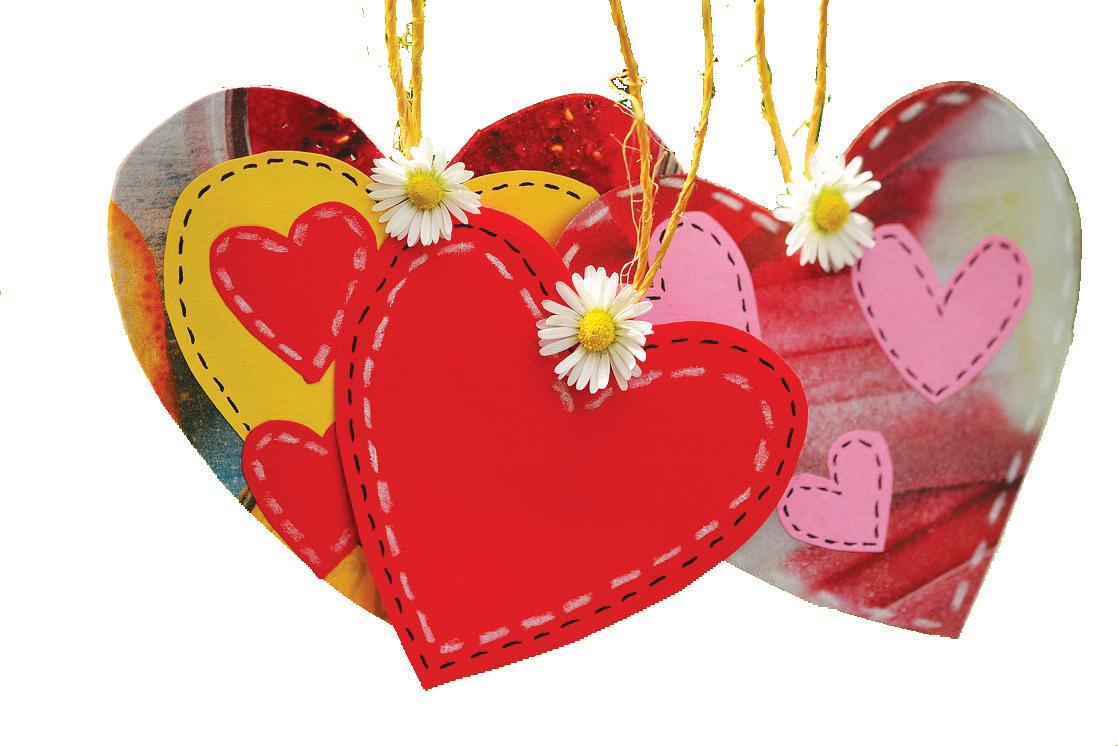
profoundly human. Whether someone sits in that room as an individual, a couple, or a family, the decision to walk through the door is an act of radical self-love and strength.
Let’s shift the lens for a moment to the people holding that sacred space — the therapists.
Therapists walk alongside their clients through some of life’s darkest valleys. They hold space for raw emotions, unexpected crises, and painful stories, offering compassion, wisdom, and guidance. They are flexible and adaptive, reshaping session plans on the fly to meet the immediate needs of the person in front of them.
Yet outside the therapy room, therapists are human too. They need rest, nourishment, laughter, connection, and care — just like anyone else. After all, you can’t pour from an
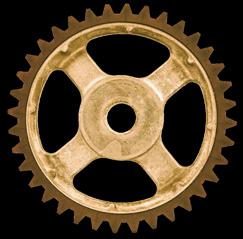



their clients not because it’s trendy, but because they know firsthand how essential they are:
• Regular movement and exercise
• Nourishing, colorful meals
• Quality sleep
• Meaningful connection with loved ones
• Moments of stillness and joy
Behind the scenes, mental health providers are quietly and tirelessly helping hundreds of people move toward lives with less anxiety, more clarity, stronger relationships, better communication, and deeper peace. And often, they may never fully know just how deeply their presence has impacted the people they’ve supported.
counselor, social worker, and mental health professional.
Through economic uncertainty, political shifts, global crises like COVID-19, and collective moments of anxiety, you have continued to show up. You’ve held space, guided healing, and offered hope, even as you navigated your own uncertainties.
So here’s a gentle reminder to you, dear providers:
Be kind to yourself.
Make space for your own healing, your own rest, your own joy. You are not just a giver of care — you are a human who deserves care, too. Thank you for the countless quiet moments of transformation you create behind the scenes. The work you do matters more than you may ever realize.



Dr. Julie Sorenson, DMFT, MA, LPC





A premier Southwest Michigan venue specializing in full weekend weddings
Enjoy beautiful ceremony sites among seasonal flower gardens and wooded backdrops, receptions in the event barn, full weekend lodging in the historic home for the wedding party, and a secluded riverside honeymoon suite for the happy couple - all conveniently located in downtown Plainwell. 414

A magical oven, indeed!
Spending youthful summers tooling around our lakeside neighborhood with my friend, Cindy, for fun we’d often look for things growing that were available for us to pick and snack.
It was the early1960s, so two young gals could run wild and free without issue until the streetlights came on.
It was a time in our lives that summer days were calendared only by significant days, which meant June was marked my birthday, and all the mulberries you could eat from a magnificent tree that grew at the Spilly house.
July was marked by Independence Day, and all the dainty tart cherries that would dangle from a tree in front of the Fortner house.
August was marked by Cindy’s birthday, and the super-ripe apricots that would grow on a tall tree behind Cindy’s house.
It seemed as though Mother Nature always had something fresh and sweet for us to feed on all summer long, which suddenly became even more significant the year that Cindy got her first Easy-Bake oven. Amazing us both with its ability to bake with nothing more than two light bulbs, we were even more impressed when it transformed the flavor of Fortner’s tart cherries into sticky-sweet mouth-watering treats.
With well over 50 years now passed, I’d all but forgotten about those pie-making days with Cindy until my dear cousin Elizabeth Kurella stirred them up when she offered me her old Easy-Bake oven that she found languishing in her basement.
A world-renowned authority on Lace Repair & Conservation, Elizabeth also delighted me with an anecdote about how she and her sister used to make delightful pies from tart cherries under their tree.
Learning that Elizabeth also had tart cherry memories tied to her Easy Bake oven simply warmed my heart, and when she handed me her oven and I saw that it was a near duplicate of the one Cindy and I had used, I experienced a moment of déjà vu.
Pulling me back in time and making me feel like a kid on Christmas day, I think the reason her gesture moved me deeply was because her Easy-Bake oven was the first oven I ever got to own.
Getting the old gal safely home, I wasted no time cleaning her up and could feel my heart speed up when it became time to test the old gal out.
Holding my breath as I carefully pressed her old, stiff plug into an outlet, my heart skipped a beat when I saw her light up.
“Yah!” I gushed with overjoyed delight.
Washing and drying all its cute

little pans, I opened my refrigerator to find some gems to place inside of them.
Perfuming my kitchen with its lightbulb-baked aroma of fresh fruit pies, Hubby remarked that it was their smell that drove him inside.
“They remind me of the little cherry pies my sisters used to make,” he sighed.
Realizing that there must be lots of us with memories tied to this oven, I suspect the true charm was never the oven per se, but rather the making and sharing of something delicious straight from Mother Nature.

Fresh-picked fruit, especially Michigan cherries, are truly an exceptional treat. Presenting us with a singular opportunity that arrives just once a year. Fresh-picked cherries are especially indulgent, more so when baked and shared.
While most of us no longer own Easy-Bakes, today’s air fryer is as good if not a better replacement because it allows us to cook petite portions and are a safer option for little ones to learn the art of baking.
Whether using an oven, an air
fryer, or Easy-Bake (new, vintage, or used), be sure to start by picking something sweet with youngsters in your life. Their little hands make short work of the tasks, pitting too, and together you’ll create sweet memories they’ll get to savor once they are old, too!
Enjoy!
Laura Kurella is an award-winning home cook who love to share recipes from her Michigan kitchen. She welcomes comments at laurakurella@yahoo.com.
Yield: 10-12 (3.5-inch) hand pies dough for 2 pie crusts
1 1/2 pounds sour cherries, pitted (lb. frozen)
1/4 cup granulated sugar
2 tablespoons unsalted butter
1/2 teaspoon fine unrefined (colored) sea salt
2 tablespoons corn starch dash of black pepper
Egg wash:1 large egg beaten with 1 tablespoon milk
To make filling, in a medium saucepan or skillet over medium heat, combine fruit with sugar, butter, salt and cornstarch. Cook, stirring, to bring to a boil. Reduce heat and simmer until mixture thickens, about 3 minutes.
Remove from heat and cool before use. [NOTE: Filling can be made ahead and refrigerated until use.]
To make pies, on a lightly floured work surface, roll out one sheet of the pie dough until it’s 12 inches in diameter and about 1/8–1/4-inch thick.
Using a cutter, cut into 4-inch circles or other desired shapes. Re-roll any scraps then cut.
Place cut circles/shapes on a cookie sheet and place in the refrigerator to chill. Repeat process with other sheet of pie crust.
Preheat oven or air fryer to 375
degrees. Line two large baking sheets with parchment paper or preferred liner.
Arrange half of the circles/shapes a few inches apart on prepared baking sheets to serve as the bottom crusts. Using a sharp knife, cut slits into the remaining circles to server as the top crusts. Place about 2 tablespoons of filling in the center of each bottom crust then set the top crust on top of the filling.
Dip a finger in water and run between the top and bottom crusts to moisten, then use a fork to crimp pie the crusts together.
Lightly brush the top of each pie with egg wash mixture. Sprinkle with some coarse sugar, if desired.
[At this point the hand pies may be wrapped for freezer storage and frozen for future baking]
To bake, place in preheated oven/ air fryer to bake for about 20 to 30 minutes, or until they’re golden brown on top and around the edges. Rotate pans halfway through baking for more even baking.
Remove from the oven and allow to cool on baking sheet for 5 minutes before transferring to a wire rack to finish cooling. Serve warm or at room temperature.

Yield: 6 servings
½ cup cane sugar
2 tablespoons cornstarch
¼ cup cold water
zest from ½ an orange
Juice from one fresh orange
1 pound of fresh cherries, rinsed and pitted (or frozen, pitted cherries)
3 cups vanilla bean ice cream
¼ cup quality brandy
In a wide saucepan, whisk together sugar, cornstarch, water and orange zest and juice until cornstarch liquifies. Place over medium heat and
bring to a boil, whisking until thickened.
Add cherries then return to a boil, then reduce heat to a simmer and cook for 10 minutes.
Meanwhile, spoon ice cream into six serving bowls. Remove cherries from heat. Pour in brandy then, using a long stick lighter, ignite the brandy to flambé. Gently shake/swirl the pan so you have a small, blue flame burning for as long as possible to help caramelize the sugars and entertain!
2 naan flatbreads
8 ounces goat (or other soft) cheese
20 fresh cherries pitted, halved
1 cup fresh basil leaves
2 tablespoons balsamic vinegar glaze
Preheat grill/broiler to “LOW” heat.
Place flatbreads on large cutting board or plate. Top with cherries then cheese then drizzle with some of the balsamic glaze.
Transfer flatbreads directly onto grill and cook until heated through, about 3-4 minutes.
Transfer to cutting board, sprinkle with basil leaves ribbons, drizzle with remaining balsamic glaze then cut and serve.
Marvelous Michigan Cherryinfused Brats
Prep time: 10 minutes; Cook time: 30 minutes; Total time: 40 minutes.
Yield: 4 servings
4 sweet or red (or mixed) onions, peeled and cut into small wedges
1 tablespoon favorite cooking fat/oil
1-ounce red wine vinegar
1-ounce pure maple syrup
1 cup cherries (any style/variety/ blend) pitted + halved
8 regular (or cherry) brats
1 fresh-ground black pepper, or to taste
1 teaspoon (or more) fresh thyme leaves
1 teaspoon (or more) freshly minced rosemary
Preheat the grill (or grill pan) to 400 degrees.
Meanwhile, place a large, heavy bottom (cast iron) skillet over mediumhigh heat. Add onions and fat/oil then sear until onions begin caramelizing, about 7 to 10 minutes.
Once onions develop caramelization, add vinegar and maple syrup, then scrape the bottom of the pan to loosen any bits. Reduce heat to low, add the cherries and the spices, to taste. Cover and let them coast as you grill brats.
Once the grilling surface has reached the desired temperature, place brats on the grill and cook, turning, until they begin to crack, about 7 minutes. As brats finish grilling, move them to cherry sauce in the cast iron skillet. Once all brats are in the skillet, cook for 5 more minutes then remove from heat and allow the pan to rest, covered for 5 minutes before serving.


2 pounds sour cherries, pitted (1½ lbs. frozen)
1/2 cup granulated sugar, plus extra for sprinkling
1/4 cup corn starch
1/2 teaspoon unrefined (colored) sea salt
9 sheets (8 oz) Phyllo dough, thawed
3 tablespoons melted unsalted butter
1/2 cup dry breadcrumbs
Garnish(optional): Powdered sugar
In a medium-sized bowl, combine pitted cherries (pitted) with the granulated sugar, let rest for 30 min-
utes, then drain cherry juice into a small saucepan and return cherries to the bowl and set aside.
To saucepan, add salt then place over medium heat and bring to a boil while stirring constantly. Reduce heat to medium-low and cook until juice thickens to a pudding-like texture. Remove from the heat and pour over cherries. Stir to combine then set aside.
Preheat the oven to 375 degrees. Line a half sheet baking pan with parchment paper or a silicone baking mat. Unroll Phyllo sheets and cover them with a damp paper towel so they don’t dry out. Lay a sheet of Phyllo on the lined baking pan with the long edge facing you.
Lightly brush the dough with melted butter then sprinkle a teaspoon of granulated sugar over the butter. Top with another layer of phyllo. Brush that layer of dough with butter and sprinkle with a teaspoon of sugar.
Repeat until all sheets are stacked and buttered.
Sprinkle breadcrumbs out in a 4-inch-wide strip across the bottom third of the pastry, leaving a 2-inch border on each side. In an even layer, pour the cherry filling over the breadcrumbs then, starting from the edge closest to you, use the pan liner to fold the dough over the cherries. Fold the two outer side ends in then continue rolling up the strudel like a burrito.
Use the opposite side of the pan liner to flip the strudel so the seam side is down and centered on pan. Brush the top of the strudel with remaining melted butter and a sprinkle of sugar, if desired.
Place in preheated oven and bake until deeply golden brown, about 35 minutes.
Cool on the baking pan for at least 30 minutes before slicing with a serrated knife.

Over a year ago, we shared a story about Whatnot—a fast-rising app that was just beginning to gain traction in live, community-driven shopping. At the time, it was most closely associated with collectible sneakers, trading cards, and niche enthusiast categories. Today, as we revisit the platform in 2025, the picture has expanded significantly. Whatnot hasn’t just stayed relevant—it has grown into a dynamic marketplace that now includes a thriving and fast-growing sector: vintage and secondhand clothing.
Whatnot’s fashion presence has taken off, driven in large part by a wave of vintage sellers bringing curated drops, era-specific styling, and garment education directly to engaged audiences. From late-90s streetwear to mid-century workwear, and everything from early Y2K to


timeless heritage brands, vintage on Whatnot is not just a niche—it’s a movement. Sellers bring knowledge, energy, and community-building into every stream, and the audience response is strong. These aren’t passive transactions; they’re lively, interactive sessions blending retail, education, and entertainment.
This growth on Whatnot reflects a much broader cultural and economic trend. Across the fashion industry, vintage and secondhand clothing continue to gain momentum, especially among younger shoppers. Gen Z and Millennials are pushing for more sustainable options, rejecting fast fashion in favor of pieces with history, quality, and individuality. For many, vintage shopping represents a form of self-expression, an environmental choice, and a way to connect with the past while dressing for the


future.
The aesthetic trends emerging within this space are diverse and layered. Oversized denim and roomy silhouettes that echo the 1990s and early 2000s are in high demand. Vintage padded shoulder blazers—long a staple in retro fashion—are seeing a major revival, especially when styled with a modern twist. Bold colors, psychedelic prints, and texture-rich fabrics like corduroy and velvet call back to the 60s and 70s, and have become popular not just in vintage collections, but in new clothing lines that echo their influence.
On Whatnot, sellers who specialize in these styles are seeing strong engagement and increasing competition. Some live streams draw hundreds of viewers, and high-demand items can spark fast-paced bidding that reflects collector excitement
and real-time community inclusion. The app’s format—part auction, part social hangout—makes it particularly well-suited to the world of secondhand fashion, where story and style go together.
It’s exciting to see how far Whatnot has come since we last wrote about it, and even more exciting to think about where it might go from here. As vintage and secondhand continue to intersect with tech, commerce, and culture, platforms like Whatnot are creating out a new kind of marketplace—one where history, creativity, and connection come first. Whether you’re a seller, a buyer, or just curious, this is a space worth watching.
Patrick Turner / Megan Zielke VintageintheZoo.com

Lighting off fireworks can inspire and foster patriotic feelings as well as be wonderful entertainment, often being a centerpiece of the summer season. But as fireworks surge in popularity so do related injuries. Visits to emergency rooms have jumped 17% in the last decade, according to one major report.
Here are some tips to keep yourself from being a fireworks-injury statistic.
Stay sober. Alcohol and other substances slow reaction time and may impair judgement. This can increase the risk of injuries to yourself and to others when you handle all types of fireworks.
Cover your eyes. Eye injuries are very common. Whether you’re lighting fireworks or just observing, consider using protective glasses or goggles.
Light right. When lighting a fuse, never hold the firework in your hand or have any part of your body over it. To be safer, use a long- handled lighting device.
Stand back. Spectators should stand back at least 35 feet away from ground-based fireworks such as fountains. Expand the range to 150 feet for fireworks that go airborne, such as bottle rockets.
Keep pets and children away. Pets are often terrified of fireworks and should be kept inside. Mitigate their risk while preserving their ability to enjoy the displays by finding a window they can watch through.
Mind the sparklers. Sparklers can be festive and fun. But they burn very hot and often cause injuries. Watch children closely while they’re using sparklers and be sure that users are wearing closed-toe shoes. Have a safe place to discard used sparkler wires to protect against burns.
Stay grounded. Fireworks that propel upward are the most likely to cause injuries. This, in part, is because they’re unpredictable and cover more distance. If given a choice, stay with ground-based fireworks. You’ll see a beautiful display or hear loud booms without the risk of an errant aerial firework veering off.
Keep water nearby. Have a container of water nearby. Submerge used

fireworks and disposable lighting devices in the water promptly after use.
Onto another topic. For the first time in 30 years, The FDA has updated the definition of what the word “healthy” means on food labels
The goal is for healthy claims to help consumers make informed decisions when shopping for groceries.
To qualify for being labeled “healthy” the food must meet: Minimum amounts of vegetables, fruits, dairy protein, or whole grains.
Specific limits for saturated fats, sodium, and added sugars.
Previously, foods could be claimed to be healthy if they met limits for total fat, saturated fat, sodium, and cholesterol, and if they met the requirement for vitamin A, vitamin C, calcium, fiber, iron, or protein. Now some foods can no longer can be claimed to healthy, including white breads, fruit punch, and products with added sugar, such as yogurt.
Updating the definition may help consumers eat a healthier diet and

lower the rates of type 2 diabetes and heart disease. If the word “healthy” is part of the product name, food companies may choose to rebrand
it if they don’t want to tinker with the recipe.
sumes that consum ers read labels before putting an item in the shopping cart. be kind and make
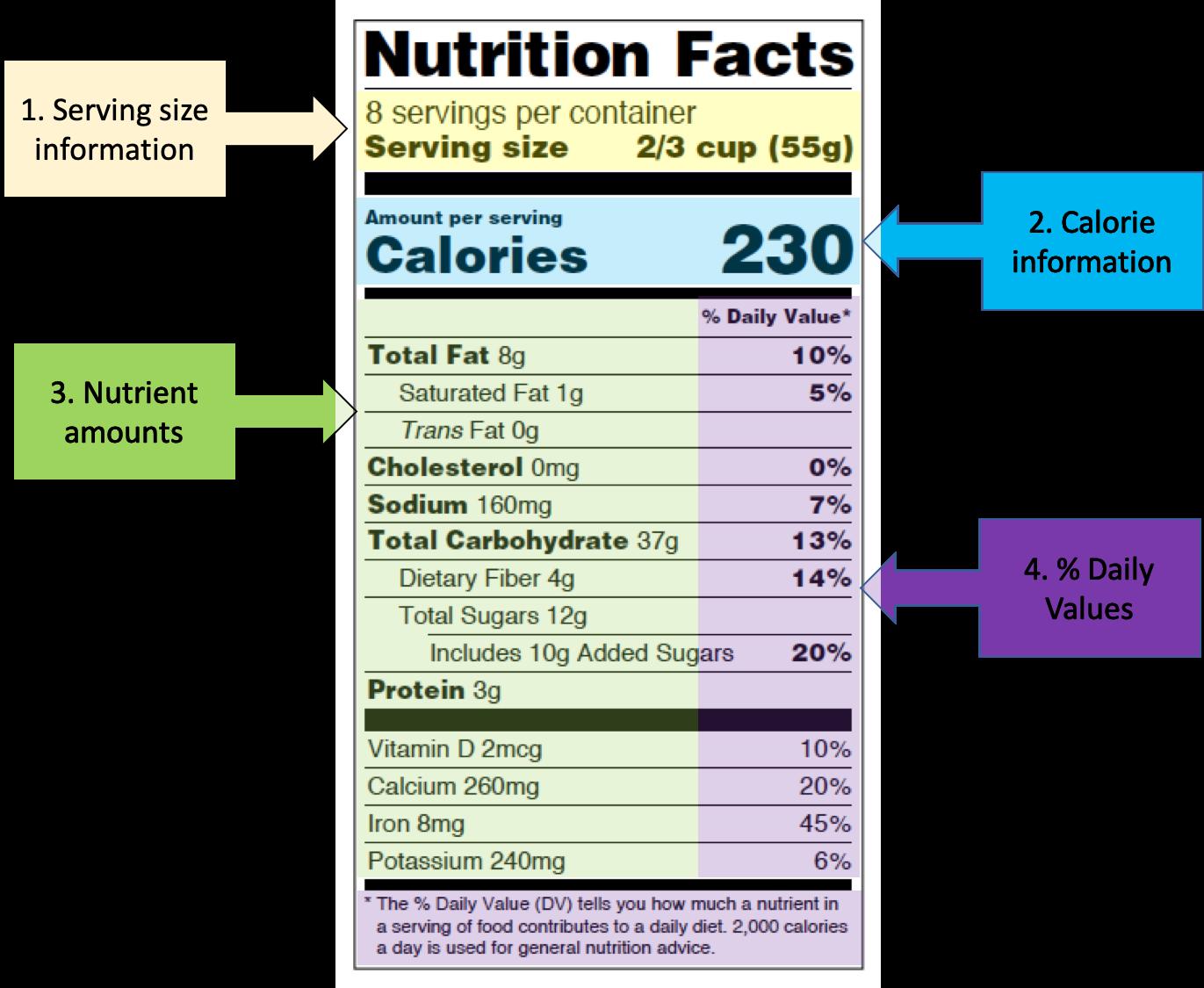
-Annual Flats -Hanging Baskets -Perennials -Herbs -Vegetables -Trees & Shrubs -Grasses -Soil -Pots -Seeds -Custom Container Pots & More!







Leo Villareal: Interstellar invites viewers into the immersive digital worlds of Leo Villareal, where code, celestial bodies, and humanity converge into a fusion of art and technology. This exhibition showcases a selection of works Villareal created during the last five years, underlining his pioneering role in the realm of digital art in the 21st century. By creating atmospheric artworks and environments where space and light collide, Villareal instills a sense of awe and wonder, offering intimate moments for both personal and collective reflection.
“We’re honored to present Interstellar at the KIA—an exhibition that brings the groundbreaking work of Leo Villareal to Kalamazoo,” said Michelle Hargrave, Executive Director of the Kalamazoo Institute of Arts. “His digital art invites us to slow down and engage deeply—with


light, with space, and with the questions that lie beyond our everyday experience. These are not traditional sculptures; they are immersive environments powered by light and code—mesmerizing, meditative, and deeply moving. For many visitors, this will be their first encounter with Villareal’s work. I can’t imagine a more meaningful introduction to how technology and art can come together to transform how we see the world—and ourselves.”
The artist’s use of light and code serves as both media and symbols that represent knowledge, discovery, and the spark of consciousness within the intricate web of the cosmos. The works on view will encourage viewers to consider the paradoxes of the universe—the vastness and intricacies of the cosmos against the fleeting nature of our existence. “Today, our world is
almost completely reliant on technology,” says Rehema Barber, Director of Curatorial Affairs. “Artists like Leo Villareal show how technology is being used to expand the boundaries of artistic practice to not only inspire curiosity for viewers but also encourage reflection about the limitlessness of the world around us and our minute, yet important place in such a vast cosmos. This is quite refreshing in the face of a technologically-driven world driven by the immediacy of information and commerce, which at times can create a sense of disconnection and despondancy.”
The exhibition is on view at the KIA through September 21 inspiring visitors to imagine the possibilities that new technologies provide for humanity’s advancement and perhaps even its preservation. Leo Villareal’s works convey the tension that exists between these congruent and at times
opposing forces, while asking viewers to reflect on their place within the grand, enigmatic expanse of the universe. Ultimately, Leo Villareal: Interstellar builds a shared journey through the known and the unknown. Learn more about Leo Villareal: Interstellar at kiarts.org.
Join us for our Gallery Gathering on July 10th, from 5:30-6pm.
Step into a unique digital world created by artist Leo Villareal during the Gallery Gathering. Using technology to explore the realms of both the cosmic and human, Villareal invites guests to wonder and reflect on our places in the universe and the journeys we share. Together, we will explore this innovative exhibition where light and code come together to create an evocative and immersive experience. This is a free event.


Baby boomer kids born after World War II were inundated with information about the war including war stories from veteran parents, parents soldier friends, veteran teachers, tv, movies, and print media. My dad told one particular war story that had a special impact on me.
Dad was an Army medical technician during WWII. He was stationed at Fort Custer when the Fort was designated a Prisoner of War (POW) camp. A German officer prisoner was assigned as my father’s aide. After my shock at finding out that Ft. Custer was a POW camp, I asked him what duties his aide performed. The German Corporal typed dad’s correspondence, took care of his uniforms, and did whatever other tasks the base pharmacy required. Dad described the Corporal as a “little old farm boy like me” whose English was “almost better than my own!” The Corporal was young, full of fun, worked hard, and got along well with the American soldiers. At the end of the war, Hitler had few able-bodied men left to fight so he started recruiting very young and very old men.
Dad was extremely loyal to the U.S. and the soldiers he took care of.


He was fully aware of the atrocities, millions of deaths, and destruction that Hitler’s war perpetuated on the world, and he made sure we kids learned all about it. Yet he formed a mutual respect for, and liked, this young German Army soldier. Dad told me that not every German person went along with Hitler’s war, but many felt they had no choice but to serve their country anyway or face dire consequences.
To understand the phenomenon of soldiers from opposing sides forming “mutual respect and understanding bonds,” I researched and found many examples of this happening during war time.* Well known examples are Capt. Partridge and Lt. Bostock becoming friends with a downed German bomber crew; US Army airman Howard Linn and German civilian informant Wilfried Beerman; the Christmas Truce; and more. It was interesting research encompassing many unique situations and soldiers’ stories.
When Ft. Custer’s POWs were reassigned after the war, some were to be sent to Russian gulags, which dad called “a death sentence.” He and other soldiers asked if the Corporal

could be released into the US or into a different country. Dad believed the Corporal had a relative in the western US and hoped he could be released to them, and because of his excellent English skills. However, none of the soldiers ever found out what happened to him.
When ancestry searches became popular, I asked dad if he’d like me to search for the Corporal. Dad thought about it for a while, then said he wouldn’t mind saying hi to him again. But I sensed some hesitation from dad. He was elderly and in poor health at that time, so I wondered if he felt he wasn’t up for the emotional stress. It may have been that he didn’t want to bring up memories of that sad time and his duties with wounded and disabled vets. Either way, he never spoke of it again, so a search for the Corporal was never done.



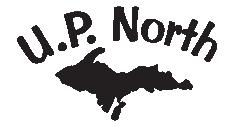
From my dad’s story I discovered valuable insights: You can turn an enemy into a friend, or establish a bond of mutual respect, by understanding who they are and what motivates them. Even if someone is your adversary, it’s possible to discover common ground and work toward mutual respect or even friendship.
I think we all need to ponder these lessons given the polarized state of politics in our country and in our personal lives today.
*Wikipedia, Guideposts, Quora, and other internet sources.
Photo: Dad on the left.
Ann Murray is an award-winning commercial illustrator and author. She has illustrated 8 children’s books, and her stories have been in three published anthologies.



Children will enjoy contraptions, dramatic play and interactive problem-solving opportunities this summer at the Kalamazoo Valley Museum, thanks to the popular claymation characters of Wallace, Gromit, Shaun and friends from the world of television, film and books coming to life in a new traveling exhibit. It will be on view from May 17 to Aug. 31.
Designed for children ages three through nine, the “Wallace & GromitTM and Shaun the SheepTM: Sheer Genius!” exhibit encourages playfully solving STEM-based and social- emotional problems in fun and engaging ways. It was created by Minnesota Children’s Museum and
Admission is free to the exhibit and to the museum.
Youngsters will step into environments of Wallace & Gromit and Shaun the sheep to explore their contraptions, antics and escapades, as well as those of other familiar Aardman Animations characters. Wallace is an eccentric inventor whose contraptions often have comical results. The floppy-eared Gromit is a kind, intelligent and loyal beagle, while Shaun the Sheep is known for his clever and mischievous ways.
As part of this hands-on exhibit, visitors will blast off in Wallace’s rocket, race to complete a puzzle


before blastoff, test out some wild contraptions with Gromit and climb around the barn with Shaun! Other activities include:
Experiment with iconic inventions in Wallace’s workshop: launch the porridge cannon, fix Autochef, and activate the Knit-o-Matic and GetU-Up- Device
Get moving around the farm by traversing the wall, balancing on barn doors and tending to plush sheep Mix up Bitzer’s face to create new facial expressions
Create a stop-motion animation using materials found in the scrap
heap Plant and harvest vegetables in the garden, deliver the mail and hop into Preston’s truck for a drive
Learn about the history and people behind the Wallace & Gromit films and see miniature props from a film For more information, visit kalamazoomuseum.org. The Kalamazoo Valley Museum is located at 230 N. Rose St. in downtown Kalamazoo. The museum is operated by Kalamazoo Valley Community College and is governed by its Board of Trustees.


Recently, while planning my garden, I came across an interesting reference to “the pollinator’s salad bar.” What? How had I never heard of this? Is it carried at my local garden center? Does it require much maintenance? Count me in!
Well, friends, as I read on, I was shocked! This Godsend to native pollinators is known by most of us as perhaps the most loathed plant invader in the forest – poison ivy. You know – “leaves of three, let it be.” Could such a thing be true? If you are one of the many readers who have nightmares just thinking about the painful blisters that arise from even gentle contact with that little devil plant or are currently in the grasp of its vicious itch, just read the rest of the articles offered in this month’s Good News Paper issue. There is no need to read my article any further! I promise to provide gentler environmental content next month. You are forgiven.
For those who can stay with me, the story of this surprising partnership between a plant and its pollinators is fascinating. But first, a bit of background…
The chemical entity responsible for the allergic reaction that results in poison ivy’s characteristic painful itch is an oily substance produced in all parts of the plant, including the roots, stems, and leaves. The compound is called urushiol and is released when any tissue of the plant is disturbed. Harsh treatment, such as grabbing or pulling at the plant, will, of course, injure more tissue and release more of the noxious oil. Even brushing against it can transfer the oil to hands and clothing, where it can then be spread by touching other body parts, such as wiping perspiration from one’s face. Dogs and cats are frequent vectors that can pass the oil, picked up innocently on their fur, to their owners after a run in the woods. Hunters can accidentally encounter
the oil as they dress their quarry. Big mistake!
Poison ivy is not the only “poison” plant in the forest. Poison oak and poison sumac are also emitters of urushiol; however, the exact chemical structure of those plants’ urushiol molecule, although very similar, is slightly different. Typically, the three plants are cross-reactive, meaning that a sensitivity to one is indicative of a person’s potential reaction to the others, although sometimes to a greater or lesser extent. Approximately 85–90% of all humans react to urushiol to some degree, and some other primates appear to be affected as well. Even the 10 – 15% of those who have not experienced the scourge are not necessarily immune. Studies show that even they can become sensitized with repeated exposure. No need to be smug if you haven’t experienced the agony. It may be only a matter of time.
Other mammals, reptiles, amphibians, and, most importantly, insects are immune to the effects of urushiol. For those species, poison ivy is a bountiful treat. The plant may be found as a low-growing perennial that can present as a woody vine or shrub, capable of spreading either horizontally to cover a wide area of the forest floor or vertically to occupy the canopy of tall trees. It is happy in either sun or shade and can tolerate dry conditions, although it is most prolific with moderate moisture. It can endure poor, rough soil as well as fertile ground.
In early spring (although in some regions of the country, pollination may occur later in the season), poison ivy produces small, yellow flowers that are attractive not only to native bees but also to many other insect species. Butterflies and hummingbirds are likewise drawn to its pollen and nectar. The result is a classic example of symbiosis. Pollinators benefit from the food resources that
plants provide. Simultaneously, the plant is rewarded by the distribution of its pollen, which fertilizes neighboring populations of poison ivy, thereby increasing the biodiversity of the entire species.
After pollination, the plant sets its fruit. Small white berries serve as a food source for many types of wild animals. Rodents, deer, and even bears are partial to the sweet fruits that are high in vitamins and carbohydrates. The most common visitors to the berries, however, are birds of many species, including those that frequently visit our backyard feeders. Robins, warblers, woodpeckers, flickers, and bluebirds are quite happy for the feast. Of course, after the main course, the seeds contained in the fruits are distributed far and wide as the animals deposit them (with a generous helping of natural fertilizer as waste), usually at some distance from the original plant source.
Even after the fruiting season has passed, poison ivy continues to give back. The stems of the plant, as they wither and die in the fall, become twigs that serve as ground shelter for rodents and the structural components of birds’ nests. Take care if you handle the nests though, as these materials may continue to be problematic for those who are susceptible to urushiol’s effects.
From an ecological perspective, poison ivy is notable as a pioneer species. As you might imagine, pioneers are the first types of plants to colonize an area that has been disturbed for whatever reason. It might be from human activity, such as harvesting a woodland area or draining a swamp for home construction. It might be a natural disruption, such as a stand of trees uprooted by inclement weather or burned by wildfire. It could even be that wild spot behind your shed that never seems to get cleared out… Poison ivy is one of the first plant inhabitants of these transitional places.
Wet or dry, sunny or shady, bare soil or leaf-covered, it’s all fertile territory for poison ivy. Its spreading habit is especially useful to the environment as it protects existing topsoil from erosion. As the plant grows, dies back, and decomposes, its biomass adds nutrients to the soil, which eventually becomes rich humus, capable of sustaining better-quality vegetation.
I’m not suggesting that we erect any monuments to poison ivy. That would be silly! I would, however, hope that I’ve provided an alternative viewpoint that might merit consideration while you are covering yourself from head to toe with protective gear and scrubbing every inch of exposed skin after that walk in the woods. There are always two sides to any story – even one about poison ivy!
Cheryl Hach
Retired Science Teacher
Kalamazoo Area Math and Science Center
References: Nafici, S. (2017, June 21). Weed of the month: Poison Ivy. Garden Stories. Retrieved June 8, 2025, from https://www.bbg.org/article/weed_ of_the_month_poison_ivy Poland, L. N. (2023, May 16). Poison Ivy: An unlikely ally. Strawberry Moon Farm. Retrieved May 29, 2025, from https://strawberrymoonfarm.com/wordpress/poison-ivy-anunlikely-ally/?srsltid=AfmBOoqfHb DhLtVGkxfEWyCsk3ANnc838I4Fa 7KLaPkCUnbZ91KulSWM (n.d.). Poison Ivy: The misunderstood native plant. Plant It Wild. Retrieved May 29, 2025, from https://www.planitwild.com/news1/ poison-ivy-the-misunderstoodnative-plant (n.d.). Urushiol. Wikipedia. Retrieved June 7, 2025, from https:// en.wikipedia.org/wiki/Urushiol
Through August 31
Exhibits Collorful Collections & The Art of Advertising Kalamazoo Valley Museum
Tues., July 1 – Thurs., July 31
Where’s Waldo – month-long Scavenger hunt in Vicksburg
Tuesdays, July 1,8,15,22,29
Kalamazoo Mini Farmers Market, 8am-1pm, 1204 Bank St.
Tuesday, July 1
Life-Sized Candyland, 10am6pm,All ages, Paw Paw Library
Tuesday, July 1
Weave a Bookmark, 11am, 3rd-5th grade, Richland Library Register ahead: 629-9085
Tuesdays, July 1,8,15,22,29
How to Draw People, grades 612, 1-3pm, Richland Library, Register ahead: 629-9085
Tuesday, July 1
Tuesdays on the Road-Food Trucks, 5-7:30pm, Midtown Fresh Parking Lot, Kalamazoo
Tuesdays, July 1,8,15,22,29 Trivia @ 468 Wine, 6:30-8:30, 8842 Portage Rd., Portage
Tuesdays, July 1,8,15,22,29 Trivia Night, 7-9pm Louie’s Trophy House
Wednesdays, July 2,9,16,23,30 Paint a Book Brick, 10m-2pm Richland Library
Wednesday, July 2
Life-Sized Candyland, 12-6pm, All ages, Paw Paw Library
Wednesday, July 2
Family Movie Matinee: Wild Robot, Free popcorn, water & Crafts, 3pm, hosted by the Richland Library @ the First Presbyterian Church
Wednesdays, July 2 & 16
Mugs & Hugs, stories & play, 10-11am, Vicksburg Library
Wednesdays, July 2,9,16,23,30 Teen Dungeons & Dragons, 3-5pm, grades 6-12, Register: 629-9085, Richland Library
Wednesdays, July 2,9,16,23,30 Richland Farmers Market, 3-6, @ Richland Community Center
Wednesdays, July 2,9,16,23,30 Trivia at the Taproom, 7-9pm, Apoptosis Brewing Co., Kal.
Thursdays, July 3,10,17,24,31
Kalamazoo Mini Farmers Market, 8am-1pm, 1204 Bank St.
Thursday, July 3
Adult Book Club: His & Hers
By Alice Feeney, 9:30-10:30pm Vicksburg Library
Thursdays, July 3,10,17,24,31
Allegan Farmers Market, 8am2pm, Corner of Water & Cutler St.
Thursdays, July 3,10,17,24,31 Free Thursdays, 11am-8pm, Kalamazoo Institute of Arts
Thursdays, July 3,10,17,24,31 Plainwell Farmers Market 3-6:30pm, 200 Allegan St.
Thursday, July 3
Movies @ Vicksburg Library, 4-6pm, Vicksburg Library
Thursdays, July 3,10,17,24,31 Teen Dungeons & Dragons, 4:30-6:30pm, Register: 629-9085, Richland Library
Thursday, July 3 Wine & Euchre, 6-8pm, Sign up ahead, 468 Wine, Portage
Thursdays, July 3,10,17,34,31
Triple Threat Trivia, 6:30pm Presidential Brewing Co.
Thursdays, July 3,10,17,24,31
King Trivia, 7-9pm, Gull Lake Distilling Co., Galesburg
Thursdays, July 3,10,17,24,31
Music Extreme Bingo, 7pm Shakespeare’s Pub
Thursdays, July 3,10,17,24,31
Music Bingo, 7-9pm, Louie’s Trophy House, Kalamazoo
Fridays, July 4,11,18,25
Live Music @ The Dock at Bayview, 8pm-12am
Saturdays, July 5,12,19,26
Kalamazoo Farmers Market 7am-1pm, 1204 Bank St.
Saturdays, July 5,12,19,26
Texas Township Farmers Market 8am-Noon, 7110 Q. Ave.
Saturdays, July 5,12,19,26
Otsego Farmers Market 9am-2pm, 112 Kalamazoo St.
Saturdays, July 5,12,19,26
Live Music, The Dock @ Bayview, 8pm
Sundays, July 6,13,20,27
Portage Farmer’s Market 9am-1pm, Portage City Hall
Mondays, July 7,14,21,28
Parchment Update Interviews Parchmentlibrary.org
Mondays, July, 7,14,21,28
Family Storytime at Clark Park, 10-11am, Books, songs, more! Hosted by the Vicksburg Library
Mondays, July 7 & 21
Teen Silent Book Club, 12:30pm, Vicksburg Library
Tuesday, July 8
Fizz, Boom, and Soar, 11am, Presented by the Kal. Air Zoo at Maple Lake Amphitheater
Tuesday, July 8
Printmaking, 3rd-5th grade, 11am, Richland Library, Register ahead: 629-9085
Tuesday, July 8 SW MI Land Conservatory: Flowers & Pollinators, 56pm, Vicksburg Library
Tuesday, July 8
Tuesdays on the Road – Food Trucks, 5-7:30pm, Woods Lake Elementary School in Kalamazoo
Wednesday, July 9 Birds & Coffee Chat on Zoom 10-11am, register: birdsanctuary@kbs.msu.edu
Wednesday, July 9
Teen Tie-Dye, 11am-1pm, Bring 100% cotton t-shirt, pillowcase, etc., Vicksburg Library
Wednesday, July 9
Summer Dance Party, 3pm Hosted by the Richland Library @First Presbyterian Church
Thursday, July 10
Teen Break & Bulldog Break, Crafts, games, social, food 2:45-4:45, Vicksburg Library
Thursday, July 10
Writers’ Motivational Group, 4-5pm, Vicksburg Library
Thursday, July 10
Portage Garden Club Evening Plant Sale, 5-8pm, 2732 Kalarama Ave., Portage
Thursday, July 10
Gallery Gathering: Leo Villareal: Interstellar, 5:30-6:pm Kalamazoo Institute of Arts
Thursday, July 10
Friends Read Book Club, 6:307:30pm, discuss what you’re reading and refreshments Paw Paw Library
Fridays, July 11,18,25 Sit N’ Stitch, 10am-12pm Richland Library
Friday, July 11
Truck & Vehicle Expo, Toddlers: 10-11am, Elementary: 11am-Noon, Vicksburg Historic Village parking lot.
Fridays, July 11,18,25
Family Story Time, 10:15 All ages, Richland Library
Friday, July 11
Memory Café – for people with Mild dementia and their care Partners, 10:30am – Noon Paw Paw District Library
Friday, July 11
Shibori Indigo Dyeing, grades 6-13, 1pm, Richland Library, Register: 629-9085
Friday, July 11
Vicksburg Farmers Market 2-6pm, 300 N. Richardson
Fridays, July 11,18,25
Xtreme Karaoke, 8:30-12pm Shakespeare’s Pub, Kal.
Friday, July 11
Vicksburg Historic Village Movie & library giveaway, Movie: Frozen, at dusk
Sat., July 12 – Sun., July 13 Garden Festival, 10am-4pm Marshallareagardenclub.org
Saturday, July 12
Riverside Cemetery Clean-up 1015 Gull Rd., Kalamazoo, 9:30am
Saturday, July 12
Friends of the Library Book Sale, 9am-2pm, Parchment Library
Saturday, July 12
Internet Users group, bring Smart Phones, 10am-Noon & questions, Paw Paw Library
Monday, July 14
Open Arms Petting Zoo, 11am1pm, all ages @ Clark Park
Monday, July 14
Parchment Book Group: What If We Get It Right? By Ayana Elizabeth Johnson, 6pm, Parchment Library
Tuesday, July 15
Mime-O-Rama, 10-11am, Presented by mime Rob Reider @Maple Lake Amphitheater
Tuesday, July 15
Printmaking, 3rd-5th grade, 11am, Richland Library Register ahead: 629-9085
Tuesday, July 15
LEGO & DUPLO Club, 1-2pm & 5:30-6:30pm Vicksburg Library
Tuesday, July 15
Tuesdays on the Road -Food Trucks, 5-7:30pm, Fannie Pell Park, Plainwell
Tuesday, July 15
Mystery Book Club: Dead Water by Ann Cleeves, 6:30pm Parchment Library
Wednesday, July 16
Mugs & Hugs, stories, activities,play, 10-11am, V icksburg Library
Thursday, July 16
Teen Craft – Keychains! 11am1pm, Vicksburg Library
Wednesday, July 16
Needle Felting, grades 6-12, 1pm, Richland Library Register: 629-9085
Wednesday, July 16
Book Discussion: Old in Art School by Neil Painter, 2-3pm Kalamazoo Institute of Arts
Wednesday, July 16
Art in the Park, 3pm, hosted By the Richland Library at the Village Square
Thursday, July 16
Main Street Mysteries & Thrillers: The Thursday Murder Club, Meet at Main St. Pub, 6pm, Vicksburg Library
Thursday, July 17
Kalamazoo Night Market, 5-10pm, 1204 Bank St.
Thursday, July 17
STEAM, 6-7pm, Vicksburg Library
Thursday, July 17
Artful Evening: BODEWADMI NDAW Screening and Potawatomi Language Workshop, 67:30pm, Kal. Institute of Arts
Thursday, July 17
Story Sips, Register ahead, 6:30pm, Parchment Library
Thursday, July 17
The Heartbreak Book Club: Savor It by Tarah DeWitt, 6:30 7:30pm, Paw Paw Library
Thursday, July 17
Slaptail Nation Presents: Slap Your Tail Comedy- Open Mic Doors open 7pm, show 7:30pm Dormouse Theatre, Kalamazoo
Friday, July 18
Mario Kart 8 Deluxe Tournament, grades 6-12, 12-3pm, Richland Library, register ahead
Friday, July 18
Vicksburg Library @ The Vicksburg Farmer’s Market, 2-6pm
Saturday, July 19
Centennial Community Day Exhibits, games & more, 11am -2pm, Kal. Institute of Arts
Saturday, July 19
Dueling Pianos, 8pm-12am Louie’s Trophy House
Monday, July 21
STEAM, hands-on/problem Solving skills, 11am-Noon Vicksburg Library
Tuesday, July 22
Jam Session with BenJammin, 10-11am @ Maple Lake Amphitheater
Tuesday, July 22
Smokey Hill laser supplies sale, 10am-4pm, Kal. Expo. Center
Tuesday, July 22
Silent Book Club (Morning), 10:15am, Parchment Library
Tuesday, July 22
T-Shirt Decorating, 3rd-5th Grade, 11am, Richland Library, Register ahead: 629-9085
Tuesday, July 22
Audubon Bird Presentation: Local Birds, 5-6pm, Vicksburg Library
Tuesday, July 22
Tuesdays on the Road – Food Trucks, 5-7:30pm, 118 N. Main St., Lawton
Wednesday, July 23
BenJammin Concert, 11am, All ages, Richland Library
Wednesday, July 23
Silent Book Club (Afternoon), 1:15pm, Parchment Library
Thursday, July 24
Teen Break & Bulldog Break, Crafts, games, social & food, 2:45-5:45, Vicksburg Library
Thursday, July 24
Family Friendly Puzzle Competition, bring team 2-4 Players, Register: 649-1648 Vicksburg Library
Thursday, July 24
Summer Jams, 6-8pm Kalamazoo Institute of Arts
Friday, July 25
Adult Jigsaw Puzzle Time, 11am-1pm, Vicksburg Library
Friday, July 25
Super Smash Bros. Ultimate Tournament, grades 6-12, 12-3pm, Register: 629-9085 Richland Library
Saturday, July 26
Rabbits Angels Rabbit Rescue Ages 4-11, read with a rabbit 10-11am, Vicksburg Library
Saturday, July 26 Grief Circle, 10am-Noon Rootead Kalamazoo
Monday, July 28
Adult Silent Book club, 10:30am-Noon, Vicksburg Library
Monday, July 28
Wolf Lake Fish Hatchery: Nature Awaits, 1-2pm Vicksburg Library
Tuesday, July 29
Foam Party: Bubble up & Boogie down for our final Party of the summer at Tyler Field, 10am-11am, Hosted by the Paw Paw Library
Tuesday, July 29
Teen Movie & Popcorn, The group chooses the movie, 1-3:30pm, Vicksburg Library
Thursday, July 31
Gallery Shop Artist Feature: Ten26 Studio, 4-8pm Kalamazoo Institute of Arts
Thursday, July 31
Story Sips, Registration Requested, 6:30pm, Parchment Library
Thursday, July 31
Between the Lines Book Club: Augustown By Kei Miller, 6:30-7:30pm, Paw Paw Library